What Is the Average Cost of Duct Sealing?
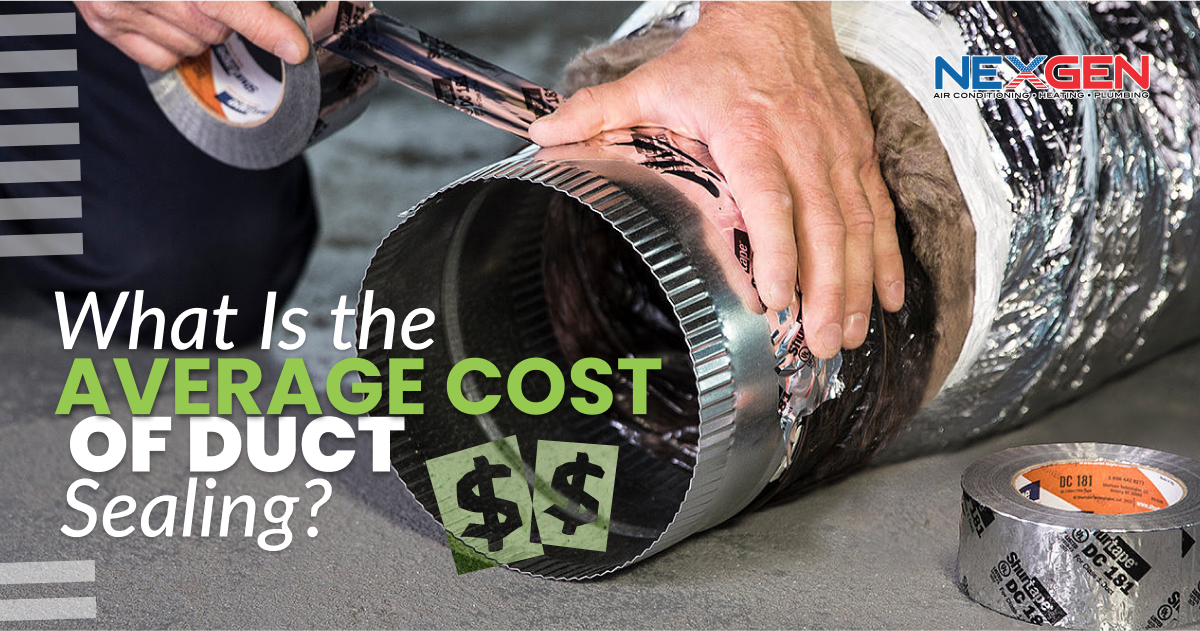
The cost of duct sealing should be a consideration for any homeowner. According to ENERGY STAR, 20% to 30% of air that moves through residential ductwork can escape through holes and poor connections.¹ Your HVAC system must compensate r the loss of heated or cooled air, which requires a great deal of energy. Properly sealing ducts can stop air leakage so your AC and heating units can operate more efficiently.
Duct Sealing Costs
As of 2024, duct sealing can cost from $500 to $4,000. The average is $2,250.² It requires inspecting HVAC ducts that run behind walls, above ceilings, and under floors. While these usually remain hidden, they can break down over time. You’ll notice the difference in reduced comfort and increased energy costs.
Sealing ducts eliminates these issues. It also has long-term cost benefits. Nonetheless, it is not cheap. We’ll look at how duct sealing is priced for each project. These are some of the factors that influence the total cost:
- The Size of Your Home: The larger your home, the more ductwork that’s required to distribute conditioned air. On average, duct sealing costs about $1 per square foot (but it can range from $0.50 to $1.50 depending on system layout and other factors).²
Not every home of the same size has the same amount and layout of ductwork. Generally, home size vs. duct sealing costs look as follows:
-
- 1,000 Square Feet: $500 to $1,500
- 1,500 Square Feet: $750 to $2,250
- 2,000 Square Feet: $1,000 to $3,000
- 2,500 Square Feet: $1,250 to $3,750
- 3,000 Square Feet: $1,500 to $4,500²
- The Sealing Method Used: HVAC ducts can be sealed manually using metal tape, which can cover large holes and gaps. This more labor-intensive approach averages about $2,250. However, an Aeroseal process requires less manual labor. The sealant is sprayed into the system and adheres to small leaks and seams from the inside. For this service, the cost averages about $1,300.²
- Ductwork Accessibility: Since air ducts run throughout your home, not all of them are easy to access. The easiest access points are the vents and air returns. However, leaks are often in duct runs in between these points. Accessing ducts in the attic, basement, or crawlspace is generally less expensive than those under tile floors or behind cabinets, especially if manual duct sealing is required.
- HVAC Duct Inspection: The average ductwork inspection costs $150. A thorough inspection before Aeroseal treatment can cost as much as $300 (if it’s not included in the total price).² Whether it’s required or not, an inspection can determine the exact source of a leak, how extensive it is, and the best method to repair it. It can also help evaluate the overall condition of your ductwork.
- Pressure Testing: A pressure test helps further evaluate the shape of your duct system. It’s often done after duct sealing to see if all leak points have been sealed. A duct fan creates negative pressure so the technician can identify signs of leakage. While it can provide valuable information, an HVAC duct pressure test can cost $200 to $450.
- The Extent of the Damage: If there are larger gaps in your ductwork, they’ll cost more to repair than small leaks. An accessible supply vent may cost just $50 to seal. A leak behind a wall, under a floor, or in the attic may cost as little as $50 to $100 to seal. The more costly projects involve addressing multiple leaks throughout the system.
How to Save on Duct Sealing
You can save money on duct sealing if you’re eligible for rebates. Many states, municipalities, and utility companies offer energy efficiency rebates on services like this. Scheduling an inspection costs money, but can save by either showing you don’t have a leak or identifying a small one to fix to improve efficiency. A pressure test confirms your ducts are sealed, so you know you’ll save on your heating and cooling bills. You can also save on duct cleaning if the technician is already working on your system.
Schedule Air Duct Sealing With NexGen
Clients throughout Southern California trust our licensed and insured technicians to seal, clean, and maintain their ductwork. Duct leaks can decrease HVAC system performance, increase utility bills, and cause noise throughout your home. We use the latest sealing methods to resolve these and other issues to make your heating and cooling system more reliable and efficient. To schedule duct sealing in your home, schedule an appointment online or call (833) 729-9735 today.
Sources:
How Do You Know If Your Sewer Line Collapsed?
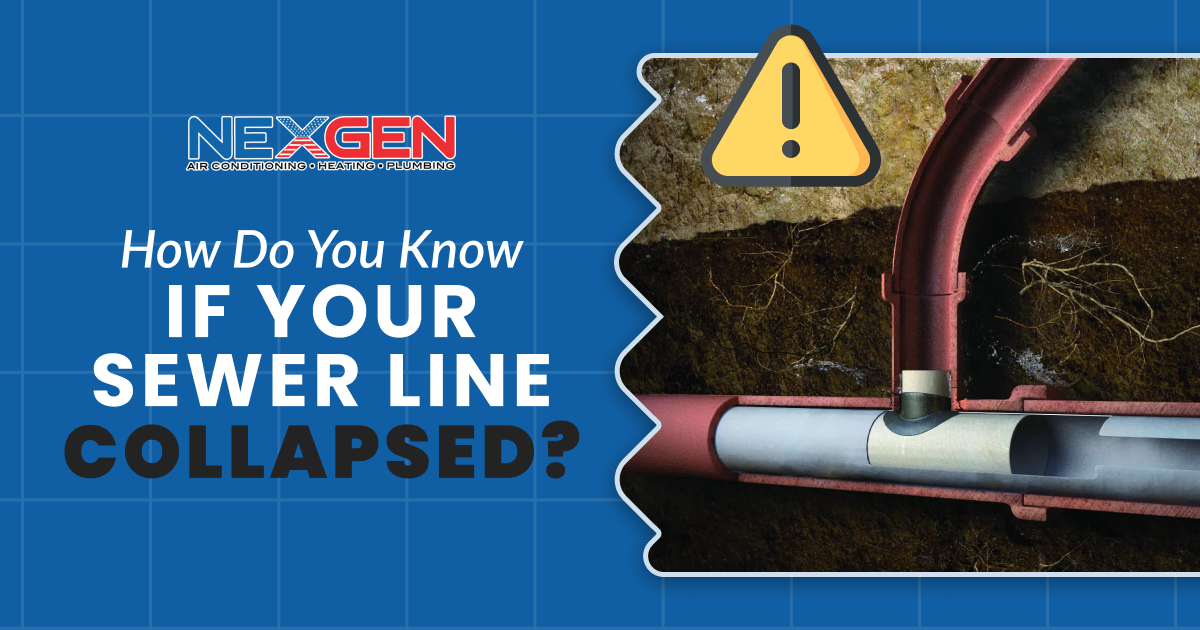
If your sewer line has collapsed, the effects are far worse than a clog. A collapsed sewer line can cause widespread problems throughout your home or business. The sooner you schedule sewer line replacement with a plumbing company in Southern California, the less costly the damage may be. Here are some telltale signs of a sewer pipe collapse so you know when to call for help.
Frequent Drain Backups
A backup can affect a toilet, sink, or bathtub. Frequent backups affecting the lower parts of your home are often due to a sewer line collapse. The collapsed section gives water nowhere to go. Instead of draining through the line, it builds up, reverses, and follows the path of least resistance.
However, the water may recede if dirt around the collapsed pipe slowly absorbs it. The signs of a problem may progress slowly over time, depending on where the collapse occurs.
Multiple Fixtures Clog Up
Every drain in your home connects to the main sewer line. If it collapses, every drain can be affected. Therefore, if multiple sinks and toilets in your home are backing up, it’s safe to assume there’s a collapsed sewer line. Water may drain slowly or not at all. The issue can manifest in only certain drain outlets, so a plumber will need to perform a camera inspection to determine where the damage is.
Sewer Gas Odors in Your Home
The smell of sewer gas is a sure sign there’s damage to the sewer system. Sewers are normally airtight except for the vent stack. A sewage backup not only smells bad. It contains bacteria, gases, and other pollutants that can spread disease and cause other health hazards.
Your Plumbing Acts Strangely
A sewer line problem can cause a toilet to suddenly start bubbling. If you hear gurgling noises from the toilet when running the sink, something is awry. You may also hear strange noises throughout your plumbing system. There are many bends, turns, and connections in your plumbing, so the effects of a collapse can be unpredictable.
Lawn Grass Grows Out of Control
If the sewer line under it is broken, one area of your lawn may be overgrown with grass. A patch of vegetation over the line can grow uncontrollably and be saturated with water. Sogginess may or may not be obvious (sinkholes can form in the most extreme cases). But if you mow the grass and an area grows faster than other parts or a patch of grass becomes saturated and dies, call a plumber to determine if you need sewer line replacement.
Your Property Is Overrun with Insects and Rodents
Insects can easily get into cracked pipes and then breed and multiply rapidly in stagnant water. Rodents love the shelter of sewers. If there are small cracks, they can squeeze through and get into your home. Both can carry germs and diseases, which is another reason to have the sewer line fixed right away.
Structural Damage
If a sewer line under your property has ruptured, water may erode the soil, causing the ground to shift under your foundation. The concrete slab and supporting walls then settle. Cracks begin to form in the slab and on the walls. Gradually, the foundation loses the ability to hold the weight of the structure. Severe erosion and ground shifting can cause a building to collapse.
What Causes a Collapsed Sewer Line?
You may need sewer line replacement because the pipe collapsed due to tree roots breaking it up. Grease and other debris buildup can also cause a sewer pipe to collapse. Pipe erosion is a common cause as well.
How Can a Sewer Line Collapse Be Fixed?
The method used to fix the sewer pipe depends on the nature and severity of the problem. A plumber can use trenchless pipe lining, which involves using an epoxy liner to create a pipe within a pipe. Another option is pipe bursting, in which a new pipe is pulled through the damaged one, fracturing the old line and replacing the damaged portion. If neither of these methods can be used, the contractor may have to resort to digging and trenching to perform sewer line replacement.
How Much Does Sewer Line Replacement Cost?
The cost of fixing a collapsed sewer line varies considerably. Plumbing contractors usually charge by the linear foot, so the more piping they replace, the more expensive the job. The price of materials, location of the damage, and repair method used also affect the total cost of the project. Replacing a sewer line usually costs several thousand dollars.
Call NexGen for Sewer Line Replacement
The leading plumbing company in Southern California, NexGen has fully licensed and insured technicians ready to address the signs of a sewer line collapse. We provide 24-hour emergency plumbing services and specialize in various methods of repairing pipes. Our team is prompt and can quickly repair a damaged sewer line on a residential or commercial property. For immediate help, call (805) 301-6788 today.
How Do I Avoid a Plumbing Emergency?
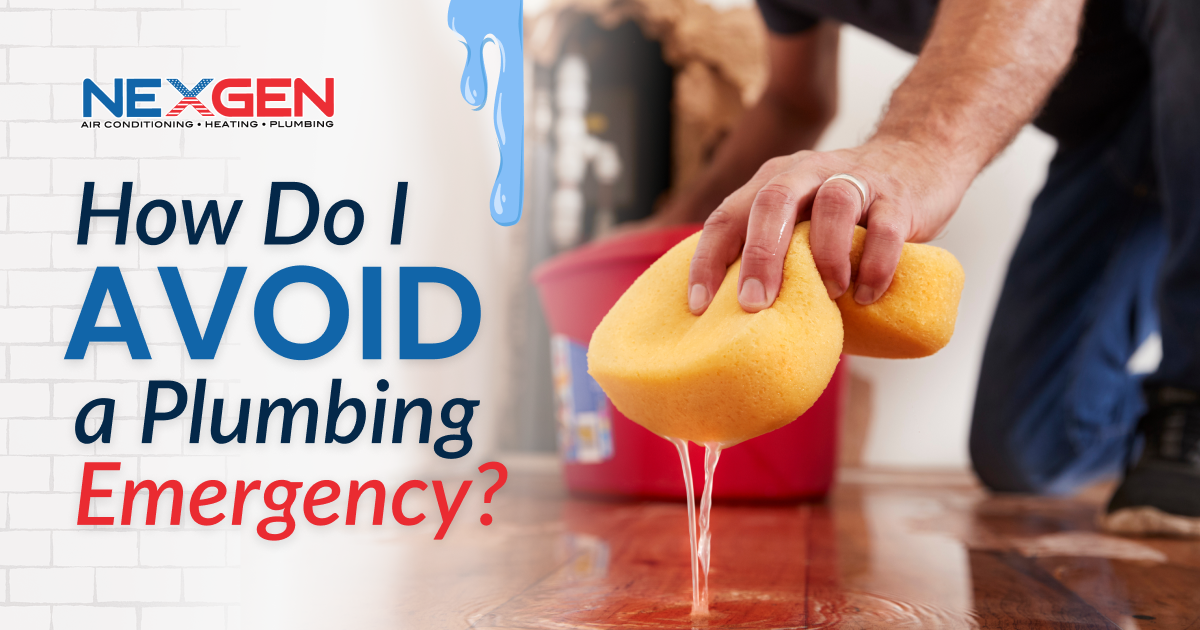
Plumbing emergencies are stressful, disruptive, and messy. Gallons of water can wreak havoc on your home before an emergency plumber arrives. However, pipe failures, overflows, and other mishaps can be avoided. Here are tips for preventing a plumbing emergency and keeping your home plumbing system in good shape.
Watch What You Put Down Drains
Whether using a sink, toilet, or garbage disposal, you can easily clog the drain line if you’re not careful. A clogged drain can cause an overflow and even damage pipes. To avoid an emergency due to a drain clog:
- Don’t Pour Grease, Fats, or Oils Down the Sink: These can become sticky and harden as they cool and attract other debris. Let these materials solidify before throwing them in the trash.
- Only Flush Toilet Paper Down the Toilet: Avoid flushing “flushable” wipes (they can get stuck in pipes) and don’t use drop-in toilet bowl cleaners. Items such as tissues, power towels, baby wipes, wrappers, and feminine products should also never be flushed.
- Be Mindful When Using Your Garbage Disposal: The disposal makes it easier to discard food scraps, but don’t add fibrous foods like celery or banana peels, cooking grease or fats, or hard items like bones or eggshells. Also, avoid putting coffee grounds, pasta, or rice in the garbage disposal.
Protect Your Drains
Use drain covers and strainers to prevent hair and other materials from clogging shower and bath drains. A combination of hair, soap, and personal care products can form a soggy mess in a drain line. Installing a simple product can prevent a plumbing emergency involving a clogged drain.
Check for Leaks Regularly
It can be easy to pass on a tiny drip or leak as not a big deal. However, if there’s any dripping or moisture around sink faucets or a valve, pipe connection, hose, or fitting, call an emergency plumber. Refrigerators, washing machines, and dishwashers are also prone to leakage. Consider replacing rubber appliance hoses with stainless steel reinforced ones as they are less likely to leak or break.
At the very least, a small leak can waste hundreds of dollars. But failing to fix one in time can lead to a costly outcome. Make a habit of checking for small leaks to avoid such a situation. Common signs, aside from water stains, include musty odors, a high water bill, a flooded/muddy lawn, and foundation cracks.
Monitor the Water Pressure in Your Home
You don’t need an exact measurement of water pressure (although gauges are available). The pressure in each home varies slightly. However, take note of any sudden drops in water pressure when washing the dishes or taking a shower. If you suspect it's from a faucet or shower head, clean the aerators. But if you don’t know why the pressure is dropping, call a plumber to check for a hidden plumbing or water main issue.
Know Where Your Water Shut Off Valve Is
Sometimes plumbing emergencies and accidents happen. Know where the main shut-off valve and fixture shut-offs are located and how to use them before anything goes wrong. When it does, you can turn the water supply off, preventing damage to floors, walls, and ceilings. Rather than replacing building materials, you may just need to dry out some wet towels or rags.
Avoid Drain Cleaning Chemicals
Store-bought drain cleaners contain chemicals that can dissolve clogs and the material that makes up your pipes. If you use them too much, you might ultimately deal with a burst pipe. To avoid this, you can use a drain snake to physically dislodge whatever is clogging the drain. However, repeated clogs should be dealt with professionally.
Flush Your Water Heater Tank Once or Twice a Year
Sediment from minerals in water can build up in a water heater tank. When this happens, the appliance will produce less hot water. It will also run more frequently, leading to increased energy usage and potentially overheating and cracking the tank’s lining. You can flush the tank if you’re equipped to, but a plumber can more thoroughly clean the tank during annual maintenance.
Schedule Regular Plumbing Maintenance
A routine inspection can avoid having to call an emergency plumber. An inspector can address slow drainage, clogged drains, low water pressure, toilets that don’t flush properly, and issues with water heaters. Skilled plumbers have various tools to test and inspect plumbing systems. They also use advanced, non-invasive methods to address minor issues and even perform some major repairs or replacements.
Call NexGen 24/7 for an Emergency Plumber
If you have a plumbing emergency, our fully licensed and insured technicians can reach your home quickly and provide an efficient solution. They’re equipped to find the cause and fix it fast. No matter the size or scope of the problem, they’ll fix it right, from a drain clog to a malfunctioning garbage disposal to a burst pipe or a gas leak. Contact us even if there’s just a small water leak. For emergency plumbing service and competitive pricing in Southern California, call NexGen at (805) 301-6788 today.
What Types of Maintenance Should be Done on a Water Heater?
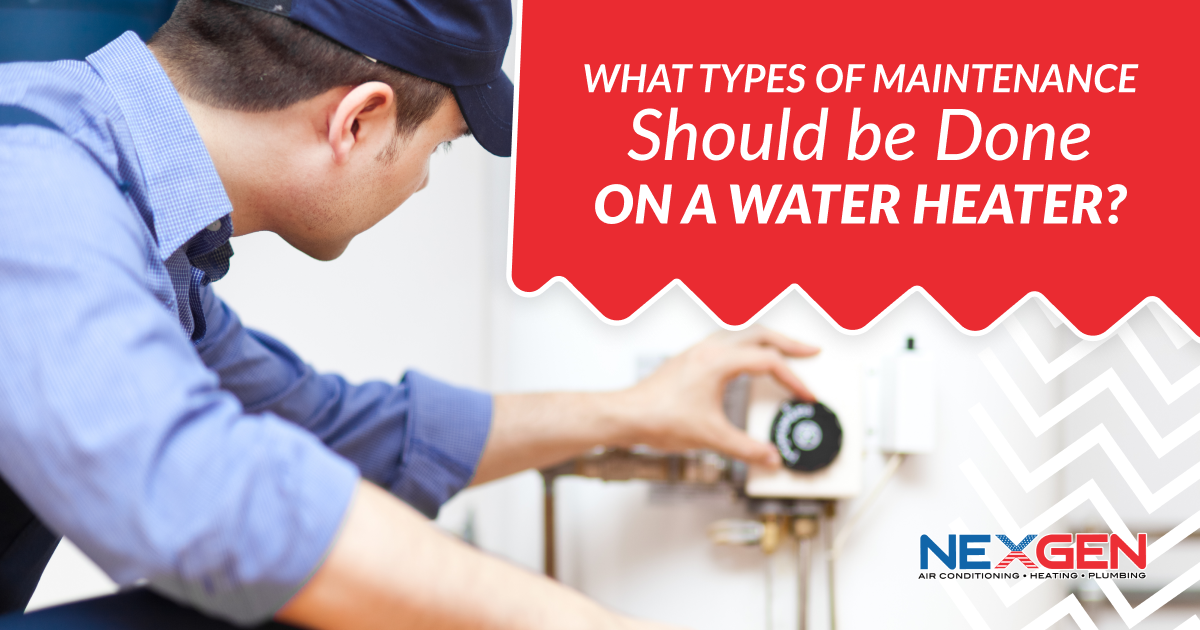
Water heater maintenance consists of various tasks, some of which you may be tempted to try yourself. It’s best to schedule maintenance service every year. A plumbing services professional has the tools and equipment to inspect and test the unit to make sure it’s working properly. The following steps enable a contractor to help your water heater run smoothly, reliably, and efficiently.
Flush the Tank
Your water heater should be flushed at least once a year. The process entails draining the unit. First, the technician turns the system off. If it’s gas-powered, the gas supply valve is shut. Next, a hose is attached to the drain valve and the valve is opened.
The water may be dark or cloudy at first, but the tech will let it run and drain until it is clear (they’ll open and close the cold-water supply valve to stir up the sediment and improve drainage); this should take 20 to 25 minutes. Lastly, the drain is closed, the tank is refilled, and the power is restored.
Check the Anode Rod
The sacrificial anode rod attracts corrosive elements, so they don’t damage the tank. Over time, the metal rod will corrode; it should be replaced every three to five years. To check the anode rod, a technician partially drains the tank and unscrews it using a 1 1/16-inch socket on the hex head at the top of the water heater.
The rod is replaced if it’s less than ½ inch thick or completely coated. It can be difficult to remove, so it’s best for a technician to check it and, if necessary, install a new anode rod.
Adjust the Temperature
A maintenance contractor sometimes adjusts the water temperature using the water heater’s thermostat. If it’s set to 140℉, that’s too high; you risk getting burned and the water heater will use more energy than necessary. Setting the unit to as low as 120℉ prevents scalding and bacterial growth.
The thermostat for a gas water heater is located on the tank. An electric water heater must be powered down by flipping the circuit breaker on the main panel. Pulling back insulation exposes the thermostat, which can be adjusted (in 10-degree increments) using a flathead screwdriver. You can lower the unit’s energy consumption by 5% for every 10 degrees you lower the water temperature.
Test the Temperature Pressure Relief (TPR) Valve
Tank-based water heaters have a safety feature that releases pressure if the water gets too hot. Since water expands when it heats, it can put immense pressure on the tank until it bursts. A maintenance tech will test the TPR valve each year. However, you can test it by lifting the valve’s lever and letting out some water. Have the valve replaced if no water comes out or flows out in large amounts (the water should start flowing and then stop). We recommend testing the TPR valve monthly.
Insulate the Water Heater and Pipes
A water heater can be covered with an insulating blanket, such as a foil-covered bubble wrap. When wrapping the tank, avoid covering the top if you have a gas or oil water heater, and fit it around the pipes, TPR valve, and temperature control. For an electric water heater, tape the edge of the insulating material to the side of the tank. Insulating the pipes going to and from the unit helps keep water hot as it moves toward fixtures and can prevent frozen pipes in winter.
Replace the Air Intake Filter
Tankless water heaters have an air intake. A filter prevents dust and debris from getting in and causing damage. If it is dirty or clogged, the unit can overheat and shut down. Therefore, replacing the air intake filter can avoid costly repairs or having to replace the water heater prematurely.
More Tips for Water Heater Maintenance
In addition to the types of maintenance described above, these tips can help your water heater run more smoothly and efficiently:
- If you have hard water, flush your water heater every six months or more often.
- Lower the thermostat temperature or use the vacation setting if you leave town for more than a few days.
- If there’s a leak, check for and tighten a loose drain valve.
- Periodically check for leaks, a hot tank, strange noises, or signs of damage.
- Keep combustible materials away from the water heater.
- For gas water heaters, check that the vent pipe is clear and the vent connector is properly sealed.
Schedule Water Heater Maintenance with NexGen
Flushing the tank and water lines, insulating the system, and testing the TPR valve can help improve the performance, efficiency, and longevity of a water heater. At NexGen, our licensed and insured technicians are familiar with every aspect of water heater maintenance and are equipped to deal with and resolve any issue. They can help you save in the long run. Our X Protection Plan includes one water heater flush per year plus discounts on repairs and other benefits. To learn more and schedule water heater maintenance and other plumbing services in Southern California, call (805) 301-6788.
How Long Does It Take to Install a Sump Pump?
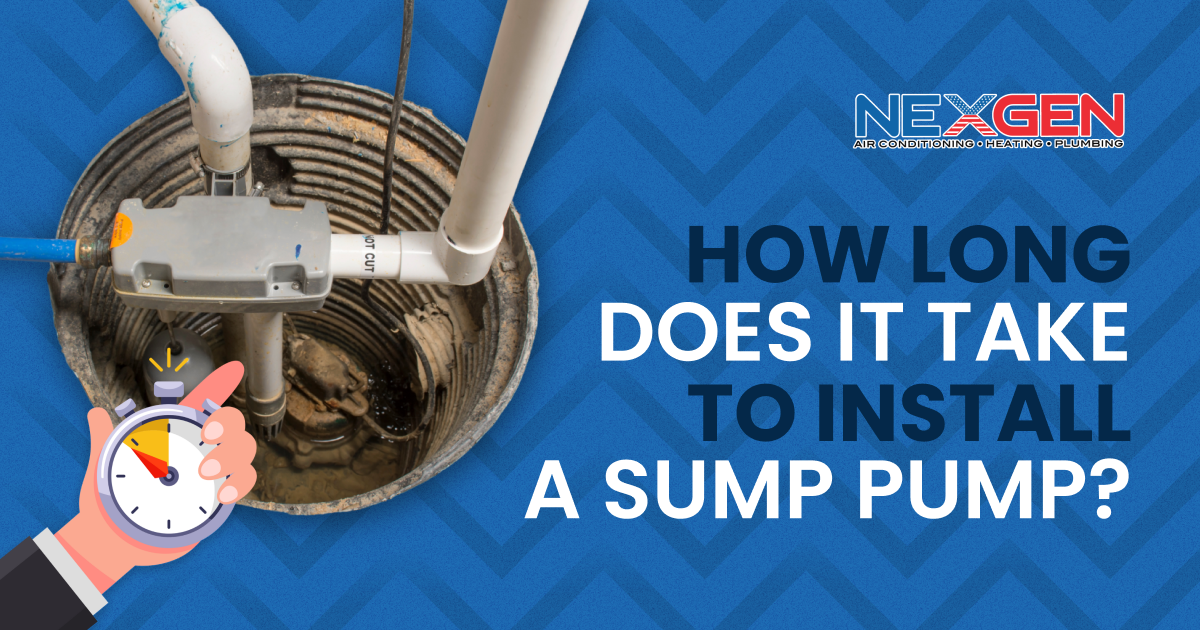
Sump pump replacement can take 2 to 4 hours; however, a first-time sump pump installation can take as long as 8 hours. A plumbing professional can install a sump pump faster than most DIYers. Taking on the project yourself can result in various problems, but we’ll look at the general process of installing a sump pump in your home.
How to Replace a Sump Pump
On average, sump pumps last about 10 years. If the system turns on and off too often, makes grinding or rattling noises, or is rusty or corroded, it should be replaced. Sump pump replacement can be a complex job with many roadblocks. A professional plumber is equipped to deal with any unexpected issues during the process.
So, you’ve set aside time to consider a DIY sump pump install. Before you attempt the installation yourself, let’s look at an overview of what must be done:
- Gather Your Tools: You’ll need a bucket (or a shop vac for removing water), a drill with a 3/16” bit, a hacksaw, primer/PVC cement, adjustable pliers, an adjustable pipe wrench, a rubber coupling boot, and zip ties. Tools can be purchased and often rented. If you don’t have them, determine if this is cost-effective.
- Remove the Old Sump Pump: Disconnect the power and then the check valve so the water can drain. Remove the old unit, allowing excess water to drain into the bucket. Clean out the pit, remove debris, and check that the bottom of the sump pit has a hard, level bottom. The base should be made of concrete or brick; setting the new pump on dirt or gravel can cause it to jam or wear prematurely.
- Connect the Check Valve and Discharge Pipe: Prime the inside of the fitting and the outer edge of the pipe (if using a glue-in valve). This ensures the glue will bond the two components strongly. Slide the coupling over the piping and attach the fitting. Then apply PVC cement to the inside of the fitting and push and twist the fitting onto the pipe.
- Measure the Pit: The sump pit’s diameter should be larger than 14 inches. This ensures the float switch fits and can function properly. The pit should be at least 22 inches deep. Also, check the distance from the bottom of the check valve to the base of the pit and the height from the ground to the center of the discharge pipe’s threading. When cutting the PVC pipe, cut it a few inches longer with the hacksaw, allowing for final cuts later if needed.
- Connect the Adapter and PVC Pipe: The male-threaded adapter is now glued to the pipe. Using the primer and PVC cement, attach the adapter to one end and thread the adapter end of the pipe onto the pump. Tighten it with a wrench. Overtightening it can cause the fittings to crack.
- Test the Sump Pump: Before fitting the pump in the pit, plug the system in and move the float, allowing the unit to run for a few seconds. If you hear the pump running, switch the float. Don’t let it continue to run dry.
- Drill the Weep Hole: Holding the pump at an angle, measure about two finger-widths above the adapter and drill a hole. The drill should be held at a 45-degree angle. The weep hole allows for water drainage and prevents damage caused by water flowing back into the pit.
- Cut the Pipe: Cut the PVC pipe while it’s elevated. Use a crate or other object to lift it off the ground. The pipe should be a few inches longer than the length you previously measured. Remove any frayed plastic with a utility knife.
- Place the Pump in the Pit: Take final measurements to ensure the discharge pipe fits under the check valve. Use towels or rags to soak up any water. Lift the pipe, cut it to its final length, drop the pump back in, and connect the piping. To test the system, fill the pit with water and see if the pump turns on and that the check valve closes when it turns off.
What to Know for a First-Time Sump Pump Installation
A sump pump is designed to keep water and moisture out of your basement. You’ll first need to decide on the type of system to install. A submersible sump pump is the most common type, and it is usually installed as your home is being constructed. It sits in a sump pit within a waterproof housing. A pedestal sump pump sits above the floor and has a motor and hose that lead to the pit; it’s often installed after a home is built and moisture issues have been identified.
When installing any sump pump, make sure it is upright to avoid flooding. Also, make sure all pipes and hoses are tight and follow the manufacturer’s guidelines for periodically cleaning the unit. Also, check for holes or damage that can prevent water from flowing away.
Should I Consider DIY or Professional Sump Pump Installation?
As you can see, sump pumps can be challenging and time-consuming to install (if you have no experience, you can waste several hours or days). Unexpected issues can lead to damage and costly repairs. An experienced technician can install a new unit or complete a sump pump replacement in a shorter time and enable your investment to last longer. They can also make sure all connections are secure to avoid flooding and other unexpected issues.
Contact NexGen
NexGen is the leading plumbing services company in Southern California. We quickly install and replace sump pumps in homes prone to basement flooding, high humidity, mold, or sewage backups. If you live in an area that floods often, let us determine if a sump pump would help. Our trained professionals also provide equipment repairs and maintenance. For a free sump pump installation or replacement estimate, call (805) 301-6788 today.
6 Signs It's Time to Replace Your Old Furnace
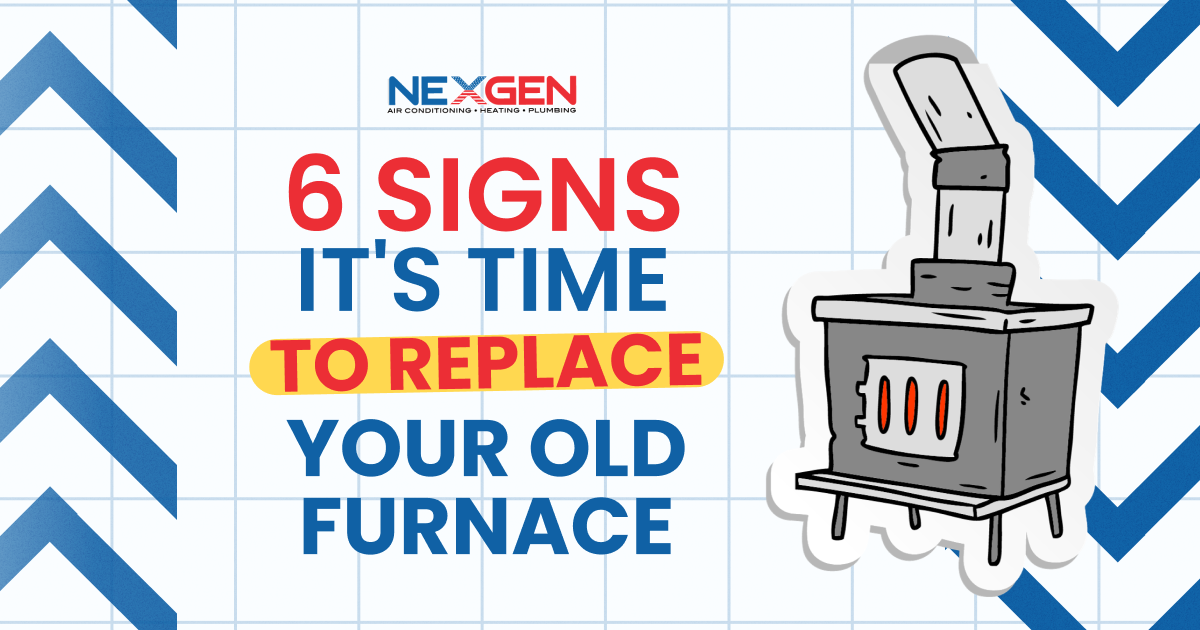
Sooner or later, it’ll be time to replace your furnace and stop paying for costly repairs. But deciding on furnace replacement isn’t always simple. There are often repair options, but while many issues can be fixed, an older furnace runs less efficiently and will likely need more repairs in the future.
A furnace can last 15 to 30 years (a gas furnace’s lifespan maxes out at about 20 years). Even if you’ve followed all maintenance recommendations and taken steps that help prolong its lifespan, here are six signs your old furnace should be replaced:
1. Loud Noises During Operation
Loud noises mean your furnace needs to be repaired or replaced. Consider purchasing a new unit if the noises return soon after a repair, don’t go away, or signal the end of the furnace’s life. While popping sounds are caused by temperature fluctuations (and should be checked if they get louder and more frequent), the following noises are of concern:
- Rattling: Loose components may be vibrating and hitting against each other; an HVAC contractor will discuss replacing the unit if multiple components are affected.
- Loud Humming: If the ordinary hum of the blower motor becomes increasingly louder, it’s time to invest in a new system.
- Screeching: Your old furnace may have a broken blower motor, belt, or pulley that’s caused more damage.
- Clicking: The flame sensor or ignitor may need to be repaired, but furnace replacement may be suggested if there are other issues present.
- Booming: This is indicative of ignition delays and can be a sign of gas emissions. If the sound is accompanied by a lingering gas odor, replace your furnace.
2. Every Room Is a Different Temperature
If each room in your home has its own microclimate (hotter or cooler than the other), your furnace may be unable to distribute heat properly. Start researching new furnaces if your heating system is aging. A 15-year-old or older furnace often becomes less efficient. Significant temperature differences between upper and lower floors indicate this is the case.
3. The System Is Blowing Cold Air
Check the thermostat to ensure it’s in “Heat” mode and set at the desired temperature. Unless the thermostat is set incorrectly, cold air from vents means your heating system is malfunctioning. A simple issue like a dirty air filter is easily fixed. But if installing a new filter doesn’t help, or a technician finds multiple issues with your old furnace, it should be replaced.
4. The Cost of Ownership Is Skyrocketing
If your furnace is struggling to heat your home, it may work harder to compensate. Or, mechanical or electrical issues are wasting energy. These issues can cause your energy bill to increase suddenly.
Frequent repairs are another reason to replace your furnace. If you’re paying for emergency service calls, parts, and labor every few months, furnace replacement may be more cost-effective over time. One way to determine if it’s not worth fixing is to multiply the repair cost by the unit’s age; if you get a number over 5,000, repairs may be too expensive.
5. Dust and Soot Are Everywhere
Dust and soot on or near the register, or collecting in parts of your home, is a sign your furnace is on its last leg. Soot buildup is a sign of increased carbon dioxide production. It can block airflow through the register and also damage furniture, shelves, and wood flooring, especially if it’s accompanied by dry air. Dead plants are a sign of low moisture levels. Consult a professional regarding furnace replacement if soot or dirt is a problem.
6. The Burner Flame Is Yellow
Your furnace should have a clean blue flame. If the flame turns yellow, there may be a gas leak or issue with the combustion process. It can also indicate the furnace is releasing carbon monoxide, which can cause headaches, dizziness, and breathing problems; the colorless, odorless gas is deadly in high concentrations. Call for help if the flame changes color and/or you smell gas in your home.
Call NexGen for a Furnace Replacement Consultation
Throughout Southern California, our fully licensed and insured technicians provide high-quality furnace repair and replacement. We’re available 24/7 for emergencies. If furnace replacement is the best option, then we’ll perform a free evaluation of your home and a free estimate. High-efficiency equipment (including heat pumps), financing options, and extended warranties are available. NexGen also offers a comprehensive monthly maintenance plan that delivers a wide range of benefits. To learn more or schedule furnace/heat pump installation or replacement in Los Angeles, Orange County, or the Inland Empire, call (805) 301-6788.
8 Reasons Why You Shouldn't Install Your Own Furnace
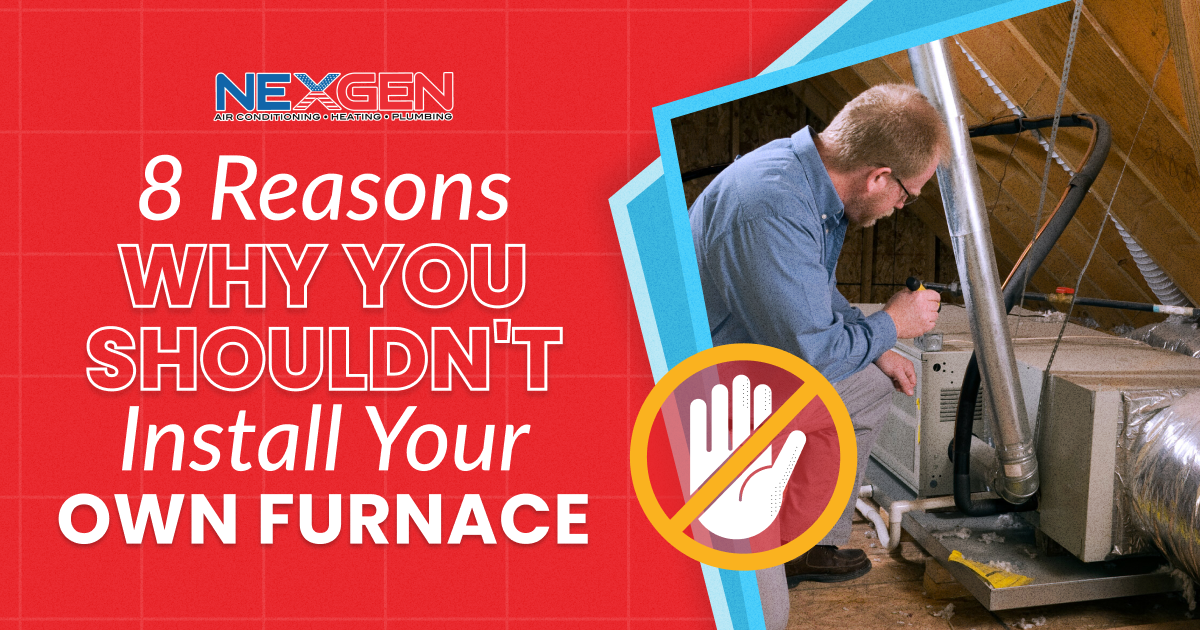
There are many reasons not to install a furnace yourself. Perhaps you just purchased a new home, built one from the ground up, or must suddenly replace your old heater while balancing other expenses. A DIY furnace installation won’t save you money. It can also be extremely dangerous. As a general rule, you should always hire a licensed and trained contractor for furnace installation.
Here are 8 reasons not to install your own furnace:
1. Do You Have What You Need?
Some manufacturers supply furnaces to wholesalers, but not many. Furnace manufacturers and suppliers rarely sell heating equipment directly to consumers. Most of them work directly with HVAC installers, so product availability (and finding a reputable source) can be a problem.
An experienced technician knows where to find the right equipment and likely has a business relationship with a reputable supplier. In addition, other parts, such as gas connection fittings, exhaust pipes, a condensate pump, and a drain line may be needed, even if replacing the old unit with the same type. And, you’ll need tools like pliers, screwdrivers, drills, hammers, multimeters, tube cutters, and others (the exact equipment required depends on the furnace model).
Given the complexity of furnace installation and everything needed to accomplish it, you should never attempt it yourself.
2. Some DIY Work Can Be Illegal
Every state has its own rules and regulations. In California, installing a furnace or other major HVAC component requires pulling a building permit, which is issued by the city or county. A permit ensures a project is inspected and meets safety and structural standards. Generally, only a professional installer has the access and resources to obtain a permit, especially when installing a gas-powered appliance.
As a homeowner, you could also pull the permit. However, any agency overseeing the process will see you as the contractor. You’ll be liable for any issues with the installation (the municipality may require you to start over if there are questions about compliance, costing time and money). A contractor is familiar with the installation and inspection process, so they’ll approach the project with every legal requirement in mind.
3. A Professional Knows How to Hook Up a Furnace
From shutting off the old system to removing it to connecting the new furnace, a professional contractor understands the entire process. Installation also often involves custom cutting and fitting pipe, duct, and vent connections and ensuring everything is properly sealed. Do you know the best-sized PVC pipe for the exhaust or the right lengths and fittings for the gas connection? Or, do you have the proper wiring or electrical capacity for a new electric furnace? Forgetting or skipping any of these considerations can have dire consequences.
4. A Furnace Must Be Sized Properly
Most homeowners who try to install their furnaces don’t know how to perform a load calculation. Improper sizing can result in inefficient heating; plus, it can strain a furnace, leading to frequent repairs or early replacement. A trained contractor can determine the best-sized furnace based on the square footage of your home, the number of rooms, window sizes, the quality of insulation, and many other factors. The size and condition of ductwork are also important considerations.
5. Furnaces Require a Solid Gas or Electrical Connection
Hooking a furnace up to a natural gas line requires a permit. Any mistakes can lead to a gas leak that can trigger an explosion and destroy your home. Using the wrong fittings or not properly securing connectors with the right tools can have devastating results. Professionals have the tools to secure and seal gas lines and detect potential leaks.
No matter what type of furnace you have, the electronics, blower, and ignition system require electricity. In most cases, the heater requires a dedicated circuit. A technician can install one and configure the hot, neutral, and ground wires. They also know where to mount the switch and other control features.
6. Thermostat Wiring Mistakes Can Affect Efficiency and Control
If you’ve never attempted furnace installation before, chances are your knowledge of thermostat wiring is limited. The more complex a thermostat, the more wires it has. Even a basic modern system may have up to four wires and those with advanced controls, multi-stage heating and cooling, etc. may require as many as 10 wires. Each wire must be fit into the correct terminal for the system to run properly.
7. DIY Furnace Installation Can Void the Warranty
Furnace manufacturers typically require a professional to install their equipment. This is often explicitly stated in the terms of the warranty. Therefore, installing a furnace yourself can void the warranty, which can have costly consequences if you make a mistake or something randomly goes wrong. You’ll have to pay the full cost of repairing or replacing the unit.
Also, your home insurance may not cover damage due to DIY furnace installation. Or, the company can cancel your policy if it finds out the work was done without a permit.
8. The System Can Malfunction and Require Costly Repairs
A good reason to hire a professional installer is they’ll ensure your furnace works. The slightest mistake or lack of precision can lead to combustion problems, which can prevent the unit from effectively heating your home. These can also cause carbon monoxide leaks, which can lead to illness and death. The system can be strained by operational, ventilation, and air distribution problems as well, so it may require frequent and costly repairs, erasing any savings you thought you’d achieved with a DIY installation.
Hire NexGen for Professional Furnace Installation
NexGen is a residential heating installation and replacement company serving Southern California. Fully licensed and insured, our technicians install many types of heating equipment, including single- and two-stage multi-speed units and modulating variable-speed systems. Comprehensive maintenance plans and extended warranties are available. To request professional furnace installation and a free evaluation and estimate, contact us online or call (805) 301-6788 today.
Furnace Sounds You Shouldn't Ignore
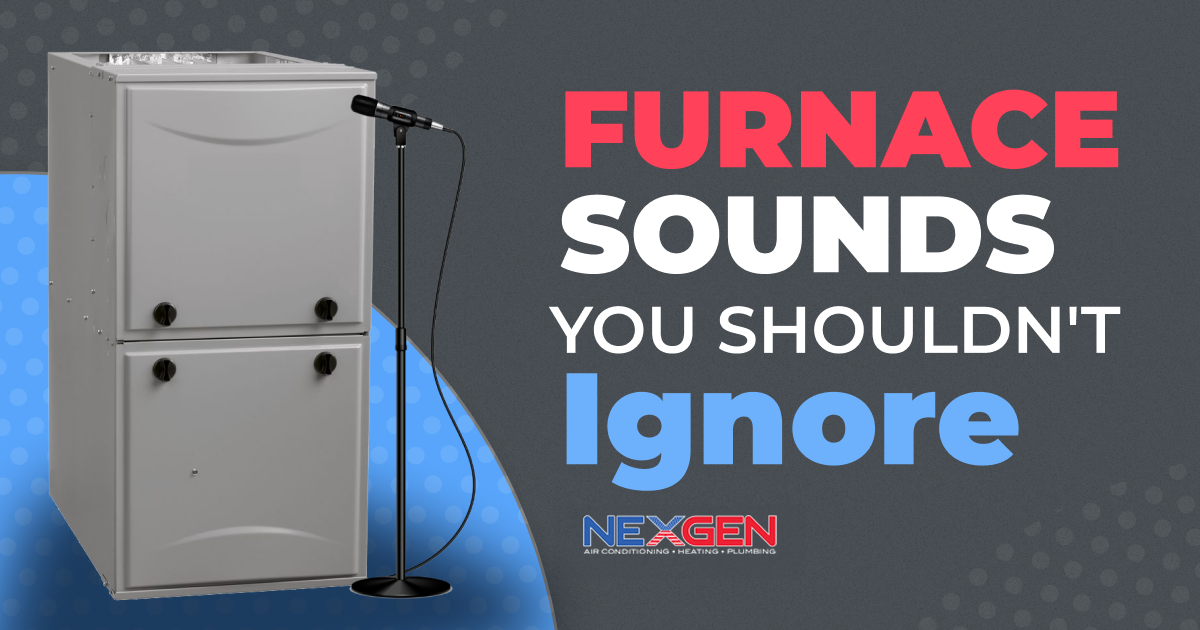
There are specific furnace sounds you should never ignore. Hearing unusual noises should prompt you to call a heating technician. NexGen provides furnace repair near you anywhere in Southern California. Our trucks are dispatched from locations in Anaheim, Northridge, Riverside, and Palm Desert. When you hear something strange from your furnace, you can reach us 24/7 and our licensed and insured technicians can troubleshoot and fix it fast.
Call for help if your furnace makes any of the following sounds:
Scraping
If it sounds like metal scraping on metal, the furnace’s blower wheel may be broken or some component has come loose. A malfunctioning blower wheel can damage the motor and waiting any longer can mean requiring a new blower assembly. Other damage to your furnace can also occur. Therefore, acting quickly can mean the difference between a fast and simple fix and an expensive repair.
Popping or Banging
If your furnace makes popping or banging sounds, the burners may be dirty. A coating of dirt causes a delayed ignition; gas builds up and creates a small explosion, creating unsettling noises. Ignoring these sounds can lead to explosions that become strong enough to crack the heat exchanger. Call for help even if the noise is more like a rumbling, knocking, or booming.
Popping noises can also come from air ducts as they expand and contract. This happens as the furnace turns on and off, so the sound may not mean it’s at risk of failing. However, there may be a ductwork issue, such as an improperly sized or poor-quality duct, that requires a professional. Or, the issue can be as simple as a clogged filter or closed vent.
High-Pitched Squealing
A squealing noise from a furnace can be caused by a few things. Usually, it’s a worn-out part, such as a frayed blower belt or a failing blower motor. A professional can easily fix these, but waiting can lead to further damage and major repairs.
Whistling
A problem with the gas valve can cause whistling noises while the furnace is running. Call an HVAC company that provides furnace repair near you, as fitting a new gas valve requires a trained professional. If the sound isn’t coming from a valve, it may be due to an airflow issue in a duct or vent. Open vents or change the filter if this seems to be the source; call for help if the noise doesn’t go away.
Rattling
Rattling noises can point to various issues. The cause may be a loose bolt in the access door, which can be tightened with a wrench. If your furnace is getting old, rattling can come from a bad blower motor fan belt, a damaged burner, or a cracked heat exchanger. Call a technician to diagnose the problem quickly, save your furnace, and prevent any safety hazards.
Chirping
A furnace might make a chirping sound when you first turn it on for the season. Although it’s not unusual, a chirp can mean the blower motor pulley is misaligned or the blower wheel is touching the mounting plate. Call a professional if the noise doesn’t go away after the furnace starts up. It’s likely some kind of trouble is brewing.
Flapping
An object, which may be as small as a piece of paper, may be stuck in the air intake. There are several places where it can get trapped. To fix this problem, a technician will need to get inside the furnace system.
Are There Normal Sounds a Furnace Can Make?
A quick pop or click as the furnace starts and a dull hum as it’s running aren’t concerning. You can expect to hear some noise as the unit starts up, runs, and shuts off.
Can I Hear If I Need a New Furnace?
Loud rattling, grinding, scraping, rumbling, screeching, and other unusual noises can mean your furnace is about to give out. A heating technician can check the system to determine if this is the case.
How Do You Fix a Noisy Furnace?
Tightening loose parts, fixing damaged insulation, and opening vents can resolve furnace noise. Lubricating the motor and other moving parts can too. If you can’t find the source of the noise or resolving it requires repairing your furnace, call a professional.
Call NexGen for Furnace Repair Near You
The #1 heating repair company in Southern California, NexGen has fully licensed, bonded, and insured technicians that can handle any problem. They can find the source of any furnace sounds you shouldn’t ignore. Whether the unit needs a new fan blade, igniter, or other part, our contractors arrive with everything needed to resolve the issue. We’re also available 24/7 if you have an emergency. Call (805) 301-6788 to request help.
Should You Repair or Replace a Leaking AC?
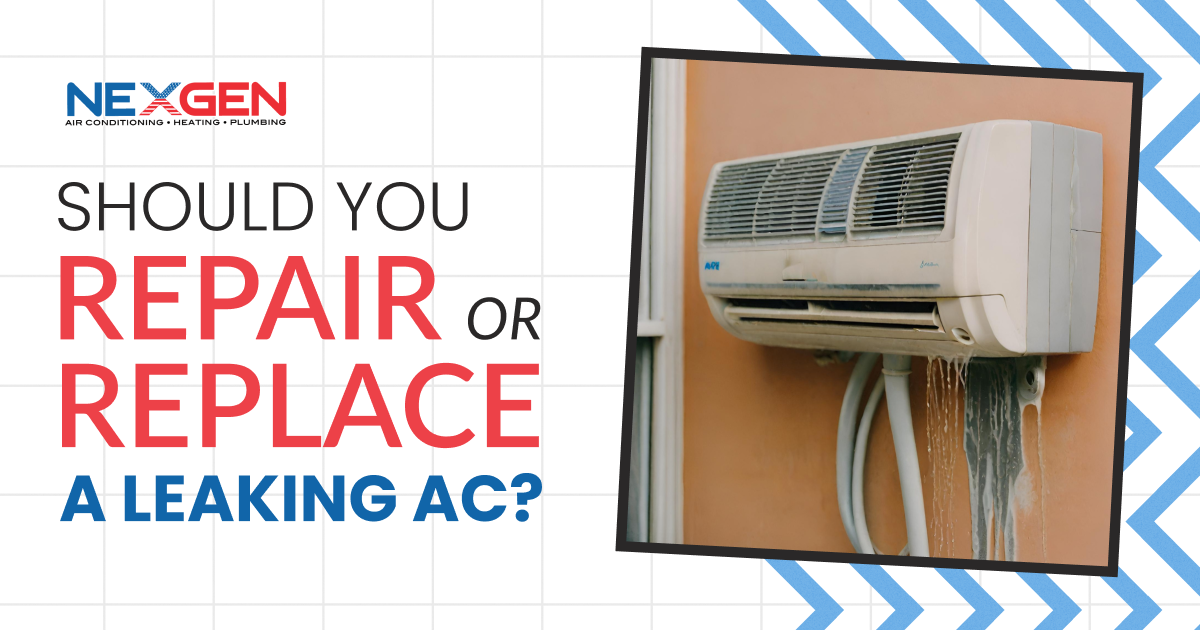
A refrigerant leak is a major problem and can leave you wondering whether to repair or replace your leaking AC. You’ll need an AC repair professional to help you decide. Refrigerant is a fluid that enables your air conditioner to cool down your home. Any AC unit can develop a leak, regardless of its age, due to corrosion, temperature extremes, and damage to coils. A leak should be considered an emergency; AC refrigerant is toxic and a loss of coolant can damage the system.
We’ll look at the following factors to help decide if a refrigerant leak warrants an AC repair or replacement:
Age of the System
Refrigerant leaks are more common in air conditioners that are five years old or more. Repair the issue if the system is relatively young. It probably has a fair amount of life left, especially if it’s less than 10 years old, so repairing a leak should be worthwhile. However, if you have an older AC, finding replacement parts may be prohibitively costly.
Cost of the Repair
A refrigerant leak can cause a considerable amount of damage. If it’s been occurring for a while, a lack of refrigerant has probably strained the system to the point major components like the compressor can fail. A compressor can be replaced. However, if your system is old and no longer under warranty, this approach is expensive.
Repairing a refrigerant leak can cost under $200 if the fix is simple. More complex jobs can cost $1,000 or more. If the job is complex and labor-intensive enough, it can cost nearly as much as replacing the entire system. As a general rule, choose a replacement if a repair estimate exceeds 50% of the price of a new unit. Or, multiply the repair cost by the unit’s age; if the result is $5,000+, replacement is more cost-effective.
Your Old AC Still Uses R-22
If your air conditioner is over 10 years old, it may use R-22 refrigerant. This product can no longer be produced legally in the U.S. Finding R-22 is extremely costly and most technicians won’t consider doing so. A more environmentally friendly refrigerant, R-410A, is readily available but can only be used in new ACs. You’re better off replacing an old AC that’s leaking.
The Cost of Your Energy Bills
How much do you spend on energy each month? Older ACs are generally less efficient than new units and even less so if there’s a leak. A technician can evaluate your system’s general efficiency rating and whether it’s properly sized for your home. If not, and several parts are worn out, and your energy bills keep going up, investing in a new AC can save you over time.
Efficiency ratings have changed over the years. Older units have lower SEER ratings, but modern ones must be rated at least 14 SEER in the North and 15 SEER in the South (as of 2023). High-efficiency models are rated at 20 SEER or higher.
Are You Planning on Moving?
If an AC repair to fix a leak isn’t prohibitively expensive, and you plan on moving within the next few years, you may not want to invest in a replacement. However, think of the condition of the system. If it’s been poorly maintained and in disrepair, not replacing it can reduce the sale price of your home. Even if you’re not planning on leaving, replacing it can provide peace of mind and avoid dealing with the hassle later.
Do the Indoor and Outdoor Units Match?
Indoor and outdoor AC units should be the same brand and model, but this isn’t always the case. If one component was replaced after the other, they may be incompatible, causing the system to run less smoothly and efficiently. And, if there’s a refrigerant leak, paying for a costly repair isn’t worth it. Installing a new, high-efficiency, perfectly matched system will save you energy and maintenance costs for many years.
Is It Still Under Warranty?
If the system is still under warranty, most repairs are worth it. But if the warranty has expired or is invalid, repairing a leak can be very expensive. Plus, if it’s out-of-warranty, chances are the unit has either been neglected or is too old to consider repairing. However, if you have an extended warranty and have properly maintained the system, that can delay your decision to replace it.
Contact NexGen for AC Repair or Replacement
NexGen provides AC repairs involving refrigerant leaks, condensate line clogs, and any other problems that arise. We also specialize in plumbing leak detection and repair. Our technicians are fully licensed and insured and available 24/7 for emergencies. They can diagnose and fix any problem and advise you on whether to replace an aging system. For high-quality AC repairs and free estimates in Southern California, call (805) 301-6788 today.
Source:
Is it Worth It To Repipe a House?
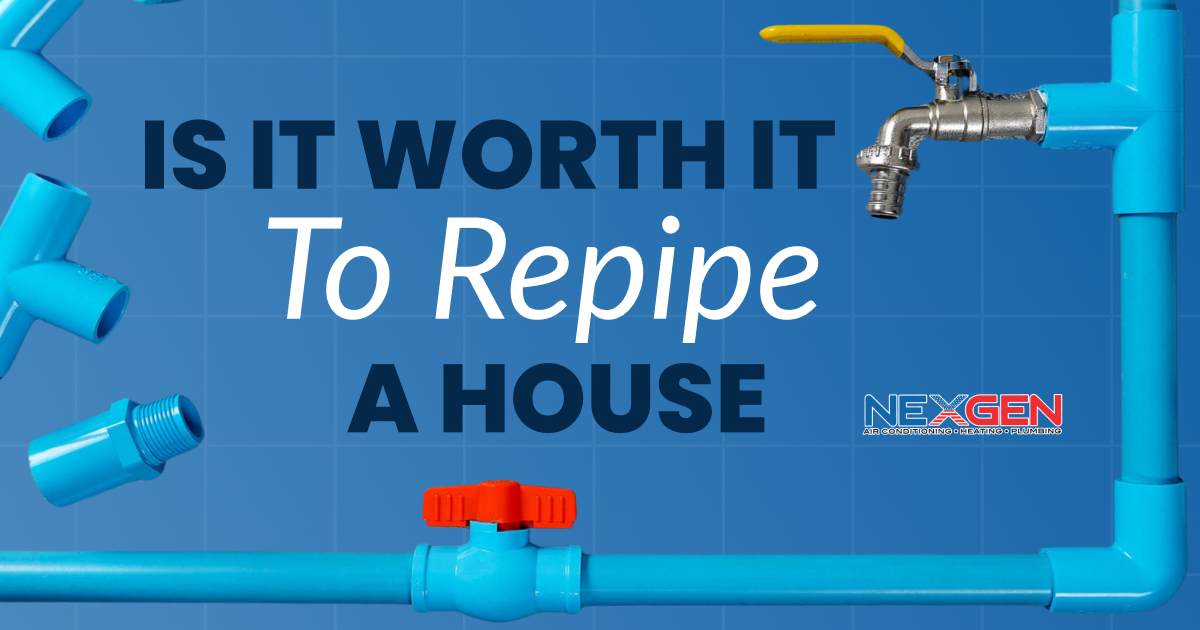
Homeowners and plumbers in Southern California often find repiping a house worth it for many reasons. The national average to repipe a house is $7,500 (although it can cost much more).¹ It is a substantial project but can have many long-term benefits. We’ll now look at why pipe replacement is a wise investment.
Repiping a house can:
Increase It’s Value
A potential buyer may see old piping as a reason not to purchase a home. No one wants to invest in a home and then have to pay to replace the plumbing system (or deal with a burst pipe, flood, or water damage). New pipes can last 100 years or more and increase your house's market value since buyers may find new pipes more appealing. Repiping can end up having a solid return on investment.
Improve Water Pressure
Old pipes can clog with sediment and limescale, causing drops in water pressure. Whether you’re cooking, cleaning, taking a shower, washing your car, or otherwise using water, low pressure can increase the amount of water you need. Daily tasks will also take more time. Replacing old pipes with new ones should increase water pressure so you can manage these tasks more quickly and efficiently.
Better Water Quality
As old pipes rust and corrode, your water supply can get contaminated. Therefore, water may taste funny, smell bad, and be unhealthy to drink. Water temperature can also fluctuate due to issues with older pipes, which can cause the regulating valve to malfunction. Water discoloration is a sign of rust or sediment buildup (especially if it’s yellow or brown). There’s no quick fix for any of these issues. If the pipes are several decades old, they must be replaced by an experienced and licensed plumber.
Fewer Plumbing Issues
Dealing with frequent plumbing repairs is inconvenient and expensive. Many problems may appear as water lines age. Weakening pipes can trigger multiple leaks. Patching each one up takes time and can lead to bigger problems later. If you often find leaks or signs of moisture on old pipes, they may be deteriorating, so a repiping project is worth it, considering the risk of a plumbing failure.
Eliminate Mold
Mold growth is another risk with old pipes. If mold is growing inside them, musty odors may spread throughout your home and a release of toxins can pose serious health risks to your family. Aside from odors, signs of mold in pipes include visible growth on surfaces near water lines and plumbing fixtures.
A combination of moisture, warmth, and the presence of organic matter creates a breeding ground for mold. Oftentimes, you can clean the affected area and improve ventilation. If the problem is severe enough, repiping may be necessary.
Why Hire Professional Plumbers Near Me for Repiping?
A DIY repiping project can potentially save on costs. However, this potential doesn’t match the benefits of hiring a professional. You would have to invest in specialized tools that require training and experience to use correctly. These can also be quite costly on their own. Plumbers can justify the costs with the profits they make on their services.
Also, repiping an old home can be dangerous. You can encounter safety hazards such as sources of electricity and gas lines. A shock or a gas leak can cause serious injury or death. If a pipe or fitting is improperly installed, water leaks, water damage, and other problems could occur and require expensive repairs.
However, a professional has the expertise and experience to successfully repipe your home and assure high-quality results. Their work may be warrantied and your old plumbing equipment will be properly disposed of. Although the upfront installation cost may be high, a plumber can save you money in the long run.
Schedule Piping and Repiping Services
NexGen is a leading plumbing services company in Southern California. Fully licensed and insured, our plumbers near you can make repiping a house worth it through their expertise, precision, and dedication. They can address any issue and have the tools and equipment to get a repiping project done on time and within your budget. For an affordable solution, fast service, and pipe installation methods that minimize disruption, call (805) 301-6788 today.
Source:


















